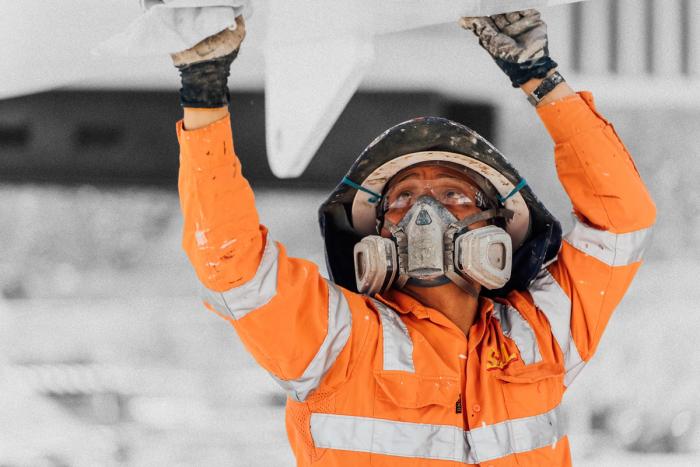Research Library
The MATES Research Library is a central hub for publications, evidence and insights that inform, evaluate and strengthen our approach to suicide prevention and mental health across our industries.
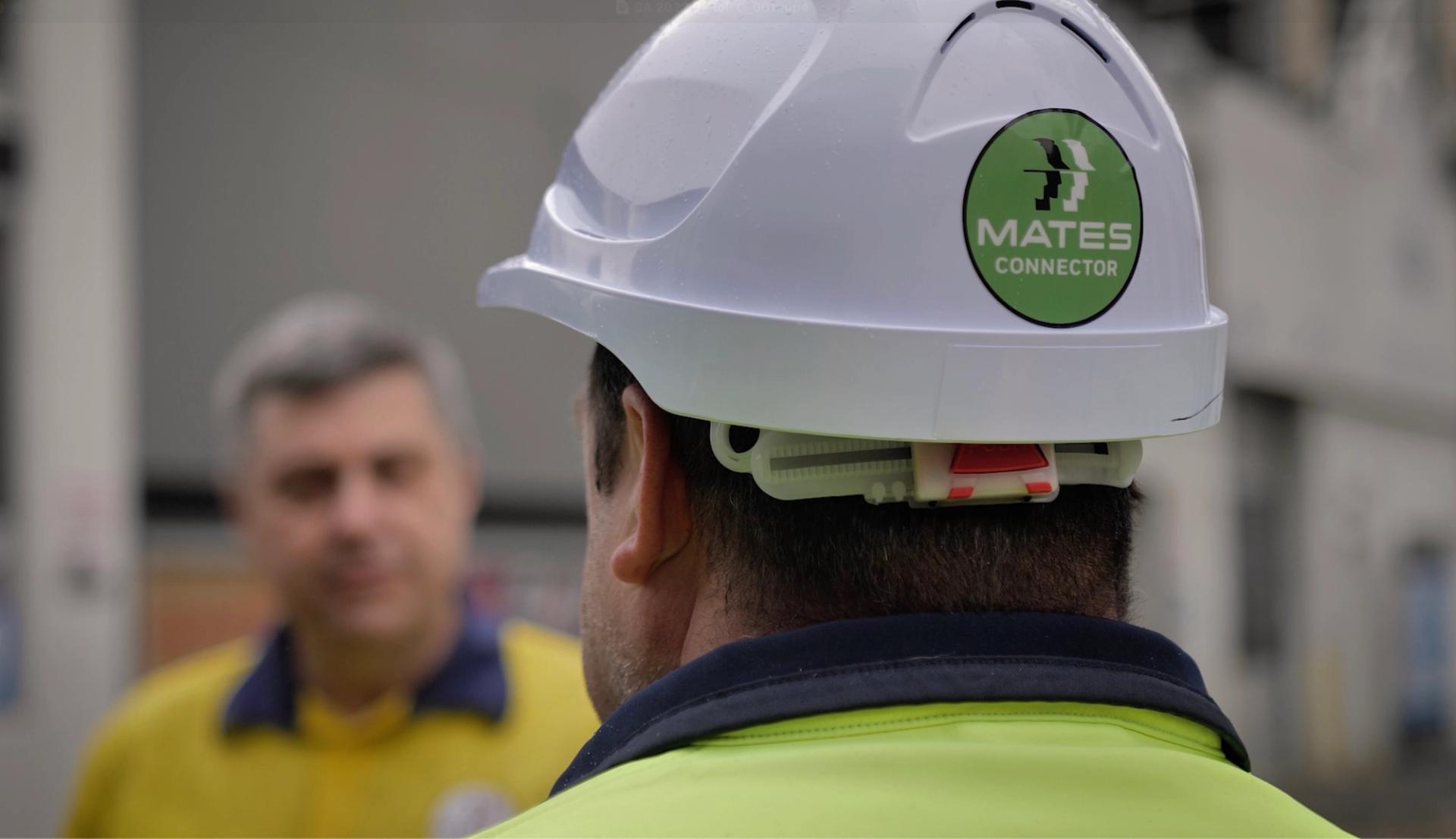
AUS
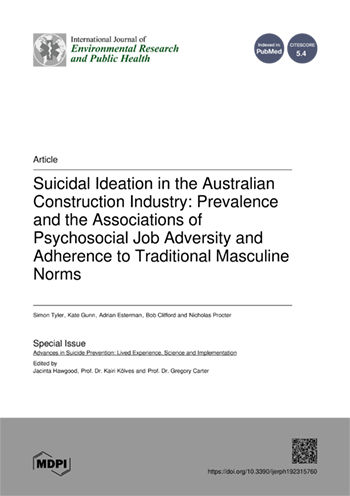
Suicidal Ideation in the Australian Construction Industry: Prevalence and the Associations of Psychosocial Job Adversity and Adherence to Traditional Masculine Norms
Publisher:
International Journal of Environmental Research and Public Health
Authors:
S Tyler, K Gunn, A Esterman, B Clifford, N Procter
Overview:
Suicide in the Australian Construction Industry (ACI) is a significant issue, however minimal understanding of suicidal ideation prevalence, as well as the potential role psychosocial job adversity an...
Suicide in the Australian Construction Industry (ACI) is a significant issue, however minimal understanding of suicidal ideation prevalence, as well as the potential role psychosocial job adversity and increased adherence to traditional masculine norms may play in its presence, is apparent. A representative sample of Australian men were used to create initial understandings of prevalence of suicidal ideation, psychosocial job adversities and level of adherence to traditional masculine norms for the ACI in comparison to a general population comprised of the remaining employed males from Other Industries.
QLD / NT
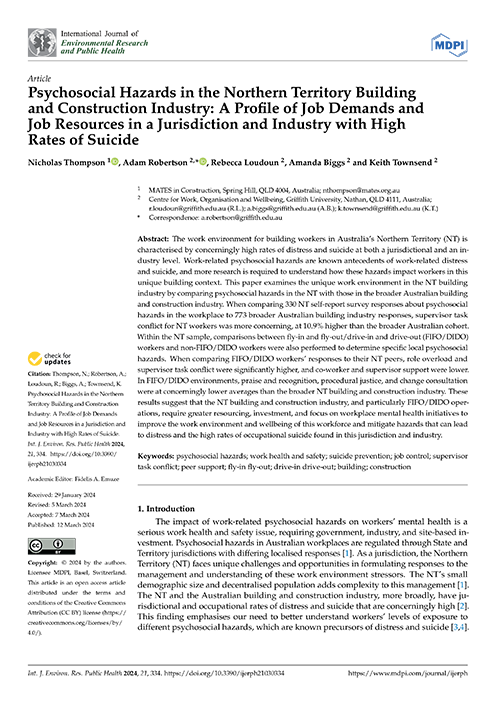
Psychosocial Hazards in the Northern Territory Building and Construction Industry: A Profile of Job Demands and Job Resources in a Jurisdiction and Industry with High Rates of Suicide
Publisher:
International Journal of Environmental Research and Public Health
Authors:
N Thompson, A Robertson, R Loudoun, A Biggs, K Townsend
Overview:
The work environment for building workers in Australia’s Northern Territory (NT) is characterised by concerningly high rates of distress and suicide at both a jurisdictional and an industry level. Wor...
The work environment for building workers in Australia’s Northern Territory (NT) is characterised by concerningly high rates of distress and suicide at both a jurisdictional and an industry level. Work-related psychosocial hazards are known antecedents of work-related distress and suicide, and more research is required to understand how these hazards impact workers in this unique building context. This paper examines the unique work environment in the NT building industry by comparing psychosocial hazards in the NT with those in the broader Australian building and construction industry. Results suggest that the NT building and construction industry, and particularly FIFO/DIDO operations, require greater resourcing, investment, and focus on workplace mental health initiatives to improve the work environment and wellbeing of this workforce and mitigate hazards that can lead to distress and the high rates of occupational suicide found in this jurisdiction and industry.
AUS
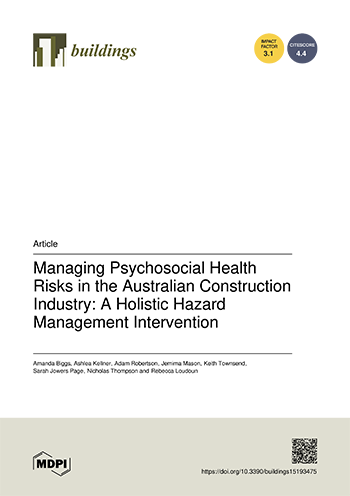
2025
Managing Psychosocial Health Risks in the Australian Construction Industry: A Holistic Hazard Management Intervention
Publisher:
MDPI
Authors:
A Biggs, A Kellner, A Robertson, J Mason, K Townsend, S Jowers Page, N Thompson, R Loudoun.
Overview:
This study presents a case study of a holistic, psychosocial hazard management intervention program in a project-based, remote workforce in the Australian construction industry. There is a dearth of r...
This study presents a case study of a holistic, psychosocial hazard management intervention program in a project-based, remote workforce in the Australian construction industry. There is a dearth of research on targeted, integrative, multi-level wellbeing interventions, and we seek to address this gap. Given the high rates of psychological distress and suicide in construction, understanding these hazards and the responses needed to manage them is critical for prevention. Data were collected from workers before and after the implementation of an intervention using an empirically validated measure of the work environment underpinned by the job demands–resources framework to evaluate exposure to psychosocial hazards, and mental health indicators, including psychological distress and suicidal ideation.
AUS

2025
MATES Respond Program: Peers Guiding Worksites Through Postvention and Critical Incident Support
Publisher:
Journal of Loss and Trauma: International Perspectives on Stress & Coping
Authors:
N Thompson, J Lacey, A Robertson, A Biggs
Overview:
Peer support and broadening the skillset of reflective practice as a point of connection in workplace settings, is a transformative component of postvention support after a peer’s suicide.
Peer support and broadening the skillset of reflective practice as a point of connection in workplace settings, is a transformative component of postvention support after a peer’s suicide.
AUS
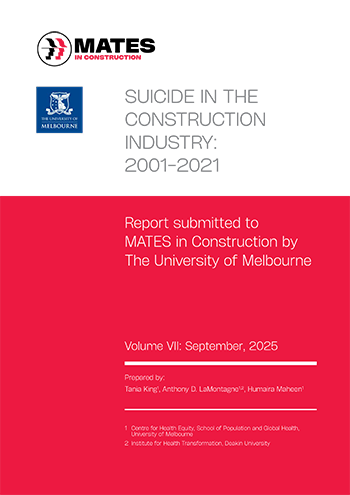
2025
Suicide in the Construction Industry: 2001-2021
Publisher:
University of Melbourne
Authors:
T King, A LaMontagne, H Maheen
Overview:
This report was commissioned to assess recent trends in suicide among construction workers across Australian states and territories, and to examine whether suicide rates among construction workers rem...
This report was commissioned to assess recent trends in suicide among construction workers across Australian states and territories, and to examine whether suicide rates among construction workers remains higher than other occupational groups.
AUS
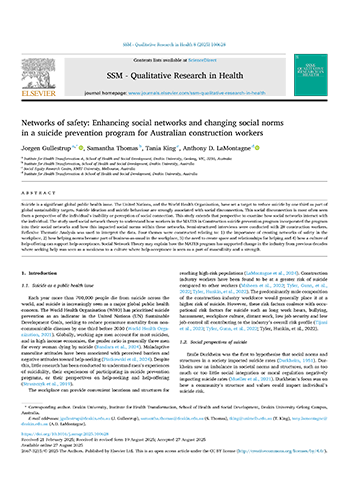
2025
Networks of safety: Enhancing social networks and changing social norms in a suicide prevention program for Australian construction workers
Publisher:
Elsevier ScienceDirect
Authors:
J Gullestrup, S Thomas, T King, A LaMontagne
Overview:
Suicide is a significant global public health issue. Suicide ideation and suicide behaviour are strongly associated with social disconnection. This social disconnection is most often seen from a persp...
Suicide is a significant global public health issue. Suicide ideation and suicide behaviour are strongly associated with social disconnection. This social disconnection is most often seen from a perspective of the individual’s inability or perception of social connection. This study extends that perspective to examine how social networks interact with the individual. The study used social network theory to understand how workers in the MATES in Construction suicide prevention program incorporated the program into their social networks and how this impacted social norms within these networks.
QLD / NT
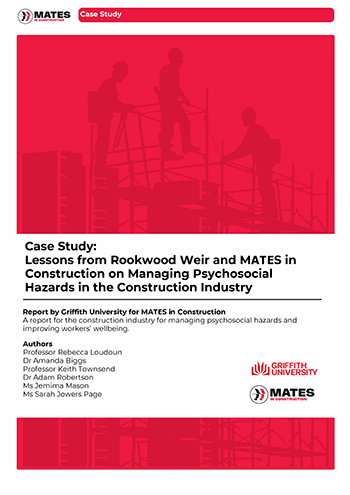
2025
Case Study: Lessons from Rookwood Weir and MATES in Construction on Managing Psychosocial Hazards in the Construction Industry
Publisher:
Griffith University for MATES in Construction
Authors:
R Loudoun, A Biggs, K Townsend, A Robertson, J Mason, S Jowers Page
Overview:
This report presents a case study of Rookwood Weird, a FIFO construction site that partnered with MATES in Construction, an industry-led suicide prevention charity, to implement best practices for man...
This report presents a case study of Rookwood Weird, a FIFO construction site that partnered with MATES in Construction, an industry-led suicide prevention charity, to implement best practices for managing psychosocial risks and improving mental health on-site. MATES' initiatives, including awareness training, peer support networks, and direct intervention services, helped create a mentally healthier work environment despite the additional challenges associated with FIFO work.
QLD / NT
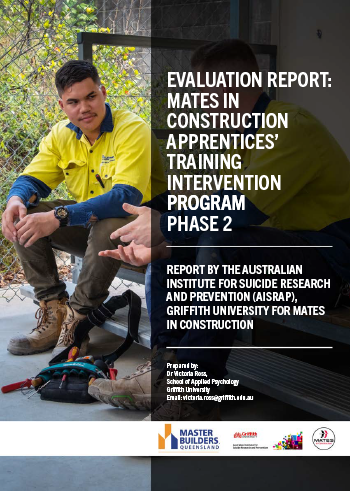
2024
Evaluation Report: MATES in Construction Apprentices' Training Intervention Program Phase 2
Publisher:
AISRAP, Griffith University for MATES in Construction
Authors:
V Ross, R Wardhani
Overview:
This research reports on the results of the Phase 2 evaluation of the MATES in Construction Apprentices’ Training Intervention Program. To address industry concerns about bullying and poor mental heal...
This research reports on the results of the Phase 2 evaluation of the MATES in Construction Apprentices’ Training Intervention Program. To address industry concerns about bullying and poor mental health in construction industry apprentices, MATES developed a threefold intervention program for apprentices and the wider industry. The program is comprised of Toolbox, Supervisor, and Apprentices’ resilience training. The Australian Institute for Suicide Research and Prevention (AISRAP), in close collaboration with MATES developed a two-Phase evaluation strategy for the training.
QLD / NT
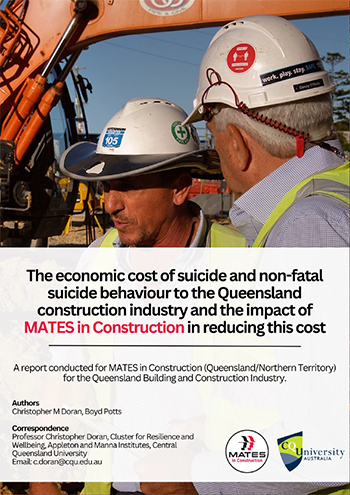
2024
The economic cost of suicide and non-fatal suicide behaviour to the Queensland construction industry and the impact of MATES in Construction in reducing this cost
Publisher:
A report conducted for MATES in Construction (Queensland/Northern Territory) for the Queensland Building and Construction Industry.
Authors:
C Doran, B Potts
Overview:
The objective of this study is to draw on the empirical research and a validated costing methodology to quantify the economic cost of suicide and non-fatal suicide behaviour to the Queensland construc...
The objective of this study is to draw on the empirical research and a validated costing methodology to quantify the economic cost of suicide and non-fatal suicide behaviour to the Queensland construction industry and estimate the impact of MATES in Construction in reducing this cost.
AUS
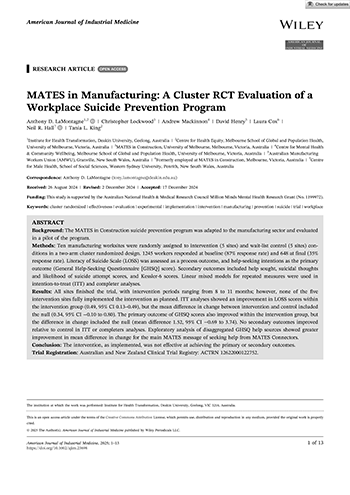
2024
MATES in Manufacturing: A Cluster RCT Evaluation of a Workplace Suicide Prevention Program
Publisher:
Wiley American Journal of Industrial Medicine
Authors:
A La Montagne, C Lockwood, A McKinnon, D Henry, L Cox, N Hall, T King
Overview:
The MATES in Construction suicide prevention program was adapted to the manufacturing sector and evaluated in a pilot of the program.
The MATES in Construction suicide prevention program was adapted to the manufacturing sector and evaluated in a pilot of the program.
